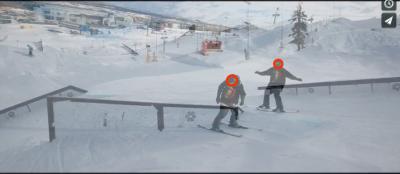Yohoo, long time since.
Realized that I was promising something about camera movement using a little rail.
These rail-thingies are funky items I've been experimenting with a little lately as I'm currently shooting a documentary on BASE jumping. So, here it comes;
CAMERA MOVEMENT USING A SLIDER/SHORT RAIL:
- the basics: It's a metal rail thing with a slider mounted on top of it. It's design to move/slide smoothly on top of the rail. On the slider itself, there's a thumbscrew that you mount your camera on. When attached, you simply slide the camera along the rail by pushing it sideways.
The rail can be mounted on top of a tripod or just placed on the ground (mine comes with small feet).
I'm using the predecessor to the
Glidetrack Aero SD (click here, it's a link). It's just over half a meter long.
- at first it felt a little odd to bring a rail attached to my backpack (when going up on a mountain to stay there for a week every gram counts). But I soon found out how much more value some slow and subtle camera moves will add to the production.
It's good for slow camera movement.
If I'm on skis I'm doing a lot of follow-caming + I'm also skiing/running around with a SteadyCam. Fast camera movement is rarely a problem when shooting the stuff we like to shoot. But the big improvements will be the small things we add; i.e. the slow stuff.
Let's use this clip from a friend/pretty accomplished film-maker as an example:
- - - - - - -
http://youtu.be/tkMq77AxQxU
Day in the Life of Tom Knox – shot by Josh Knox (who was one of the camera guys for Team America during JOSS 2010). Check these sliding moments out:
0:12 Tom dresses
0:15 another shot of him dressing
0:21 making pancakes.
2:27 camera moves sideways while Tom does the kickflip
2:41 same kind of subtle movement while Tom grinds that concrete wall
- sure, Josh used a crane + a lot of handheld panning and fast camera moves in this edit, but... in my book it's those smooth and subtle things that are adding the extra oomph to the production. Don't you agree?
- the trick to great sliding shots is to use any object that is close to the camera. In the 0:21 shot of Day in the Life... where Tom is making pancakes, the effect of the camera on the slider is so much greater because of the parallax effect (maybe the phenomena of parallax will become a new post one day).
- in short, when you have only a short rail, you must have things close to the camera to get the most out of the sliding cam, otherwise you'll need a long-ass rail (try to bring that with you on the mountain...).
- - - - - - -
Static cams – if everything moves, your audience will get seasick.
I bet that Josh's edit would be completely unwatchable if everything was moving, sliding, panning and floating around, therefore... let's check out some static shots.
- note the static shots at 1:06 and 1:10. Tom is constantly moving, skating into the frame and out. Camera is completely still.
- the close up static shot at 1:30 – where he let's Tom skate into focus and out out of it – and at 2:10 where Tom passes by in pretty perfect sharpness with a very short depth of field.
- the 1:30 and 2:10 shots need a little more planning, but they're by no means complicated to shoot. You basically just set the sharpness on a spot and then make sure that your friend will skate/move/ski just there.
If you ask me, these shots add a lot to the total flow of the entire edit. Josh didn't do much extra work to get them but like most good filmmakers, he planned for them to be shot and did it.
It's like the Godfather of Soul, James Brown, used to say:
”Silence is a rhythm too...”
End of lecture. Have a good one, friends!
